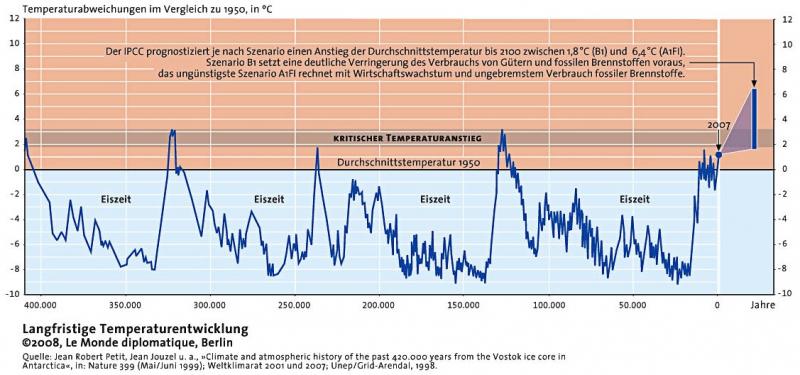The drilling and investigation of ice in the Antarctic and air bubbles trapped in it has led to the generation of values for the last 420,000 years indicating the concentration of CO2 in the earth’s atmosphere in ppm (parts per million) and fluctuation in average temperature on earth. That higher levels of CO2 concentration coincide with higher temperatures, and vice versa, points to the concentration of CO2, a greenhouse gas, as a determining factor in climate change. Currently, CO2 concentration in the earth’s atmosphere is higher than at any point during the last 650,000 years. The IPCC (Intergovernmental Panel on Climate Change) predicts that by 2100, the temperature will increase by a further 1.8°C—if there is a significant reduction in the consumption of goods and fossil fuels. However, if current trends in economic growth and the consumption of fossil fuels continue, this increase may be as much as 6.4°C. The earth could survive such an increase. The human race could not. All rights reserved. © 2008, Le Monde diplomatique, Berlin. Made available on the Environment & Society Portal courtesy of Le Monde diplomatique, Berlin. You may use this content only for your personal, non-commercial use. More information about Le Monde diplomatique maps and climate change.
- Chakrabarty, Dipesh. “The Climate of History: Four Theses.” Published online at Eurozine, 30 October 2009. First published in Critical Inquiry 35 (Winter 2009): 197–222.
- Chakrabarty, Dipesh. “Verändert der Klimawandel die Geschichtsschreibung?” Transit. Europäische Revue 41 (2011): 143–163.
- Steffen, Will, Jacques Grinevald, Paul Crutzen, and John McNeill. “The Anthropocene: Conceptual and Historical Perspectives.” Philophical Transactions of the Royal Society A 369, no. 1938 (13 March 2011): 842–867. doi: 10.1098/rsta.2010.0327.



